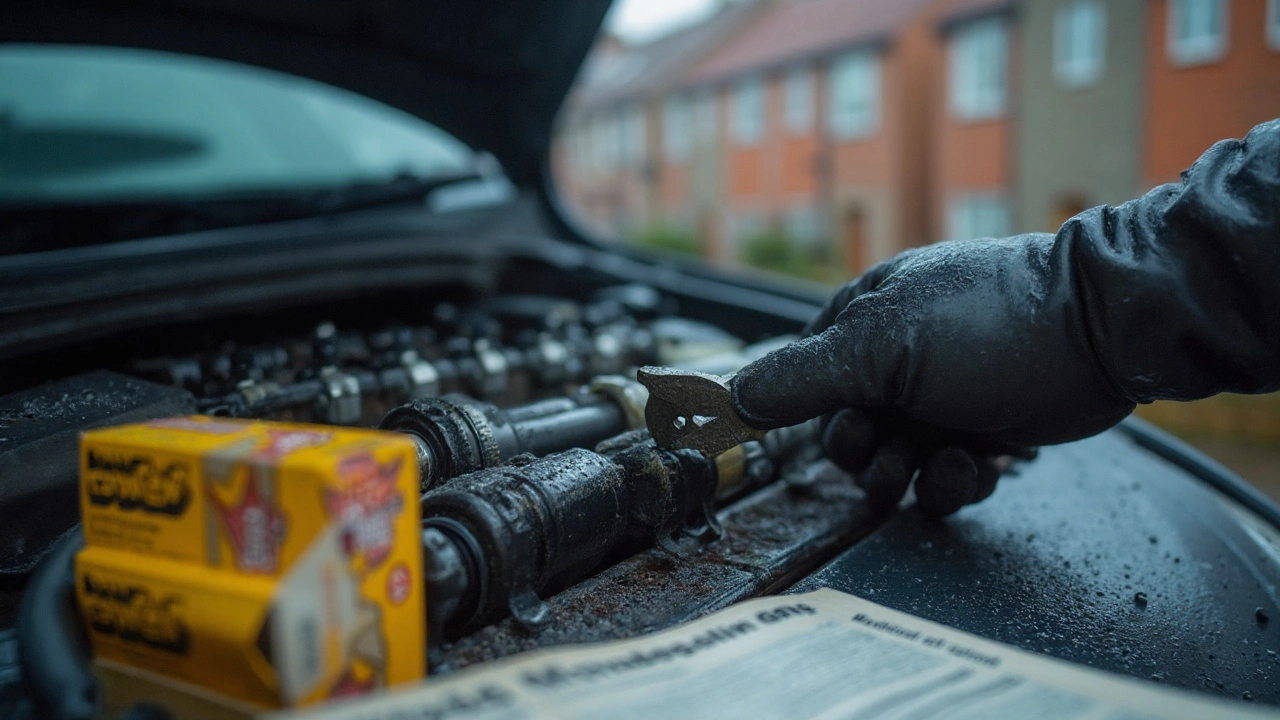Swapping spark plugs hoping for a quick power bump? Here’s the honest bit: fresh plugs rarely “add” power to a healthy engine; they mostly give back what worn plugs have been quietly stealing. There are exceptions-tuned and boosted setups, misfire-prone cars-but if your engine’s already happy, a plug change won’t magically unlock hidden ponies.
TL;DR
- New plugs don’t create horsepower; they restore it when old plugs are worn, misfiring, or gapped wrong.
- Healthy stock engines: expect 0 hp change. Worn plugs: you might regain ~1-4% of rated power and smoother throttle.
- Modified/turbo cars: correct heat range and gap can prevent knock and misfire, enabling safer timing/boost (the tune makes the gains).
- Pick the OEM plug type and heat range; set the right gap; torque correctly. Avoid gimmicky multi-electrode or “miracle” plugs.
- Typical service life: copper ~30k miles (48k km), platinum/iridium 60-100k miles (96-160k km). Check your owner’s manual.
What spark plugs can and can’t do for power
My son Jasper loves asking if a simple part can make a car faster. I wish the answer were a neat yes. The truth: spark plugs don’t “make” power-your engine’s compression, airflow, fuel, and timing do that. The plug’s job is to light the mixture reliably, cycle after cycle, across the rev range. When it does that without drama, you get the power your engine was built to deliver.
So why do people swear they felt gains? Because a fresh, correctly gapped plug can clean up a weak spark, a borderline misfire, or a plug that’s heat-soaked and fouling. That feels sharper and stronger, especially under load. Technically, you didn’t add power-you stopped wasting it.
“Spark plugs do not create horsepower; they ignite the air-fuel mixture. Worn or incorrect plugs can reduce performance, efficiency, and drivability.” - NGK Technical Resource
Ignition stability matters. SAE research on combustion shows that a stable, well-timed spark improves cycle-to-cycle consistency. Misfire or slow/flaky ignition hurts torque and pushes hydrocarbon emissions up. You feel that as a stumble, a flat spot, or just a car that won’t pull cleanly to redline.
Here’s the sanity check I use in the garage in Manchester:
- Healthy, stock engine + correct plugs + correct gap = no power increase from a plug swap. You might notice smoother idle and better cold starts.
- Worn plugs (rounded electrodes, big gap, ash deposits) = you can regain a small but real chunk of lost grunt.
- Modified/boosted engine = the right heat range and gap help the engine hold spark under pressure. That doesn’t add power by itself; it lets your tune safely run the timing and boost you paid for.
Material myths. Copper/nickel, platinum, and iridium all fire the mixture. Copper conducts best but erodes fastest; iridium resists wear and holds a sharp edge for ages, which keeps the spark stable over time. That’s why many modern cars come with iridium or platinum. Stability and longevity, not raw “spark intensity,” are the win.
Heat range confusion. A colder plug doesn’t make power. It keeps the tip cool enough under high load to avoid pre-ignition. A hotter plug keeps the tip warm enough in gentle driving to burn off deposits. Both are about reliability and knock avoidance, not horsepower. On a tuned turbo car, going one step colder and tightening the gap can prevent high-rpm blowout so you can keep your timing-indirectly protecting power.
What about fancy multi-electrode or “pulsed” designs? Independent dyno pulls on stock engines rarely show measurable gains beyond what you’d see from fresh OEM-spec plugs. Stick with the spec that matches your head design, reach, seat, and heat range. The clever bit is choosing correctly and installing them right, not chasing magic electrodes.
Realistic expectations by scenario:
| Scenario | Engine Condition | Plug Action | Expected Change | Why You Feel It | Notes |
|---|---|---|---|---|---|
| Healthy stock daily | No misfires, normal fuel trims | New OEM-spec plugs | ~0 hp; smoother idle | Stability restored, but you weren’t losing power | May see small mpg improvement |
| High-mileage stock | Worn electrodes, wide gap | New, correctly gapped plugs | ~1-4% of rated power “back” | Fixes weak spark/micro-misfires under load | Throttle feels crisper |
| Lightly tuned turbo | Mild knock, high-boost blowout | Colder heat range, tighter gap | 0 hp by itself; enables more timing/boost | Holds spark so the tune can add power safely | Retune often required |
| Track/High RPM NA | Consistent load, hot chambers | Correct range, precise gap | 0-1% from stability | Cleaner burn lap after lap | Indexing sometimes helps a whisker |
| Misfiring engine | Misfire codes present (P030X) | New plugs + fix root cause | Varies; can be dramatic | Restores cylinders that weren’t contributing | Check coils/leads/injectors too |
Big picture: if you’re chasing dyno numbers, plugs are a reliability mod that protects your power. If you just want your car to feel right again, they can be the missing piece-especially when the old ones are tired.
SEO note: If you landed here searching for spark plugs horsepower, the short answer is no for healthy cars, and yes-but only as a recovery-when the old plugs were holding you back.

Choose, gap, and install the right plugs (step-by-step)
I’ve seen more power lost from the wrong plug or a sloppy install than gained from any exotic electrode. Here’s a simple, no-nonsense process I use in the driveway between rain showers here in Manchester.
-
Confirm the exact spec. Look up the part number, reach, thread, seat type (gasket vs taper), resistor type, and heat range in your owner’s manual or the manufacturer’s catalogue (NGK, Denso, Bosch). Don’t “cross-reference” by guesswork; minor differences can cause trouble. If your engine is tuned, speak to your tuner about heat range and gap.
-
Pick the right material for your use.
- Copper/Nickel: Great conductor, crisp spark, shorter life. Good for older engines or track days when you inspect frequently.
- Platinum: Long life, decent stability. Common OEM fit on many 2000s cars.
- Iridium: Very long life, fine-wire tip holds shape, strong at high rpm/lean cruise. Often best for modern daily drivers and boosted cars for consistency.
-
Set the correct gap. Even “pre-gapped” plugs arrive out of spec sometimes. Use a wire-style gauge (not a wedge/coin that can bend the fine tip). Typical gaps: 0.7-0.9 mm (0.028-0.035 in) for many turbo engines, 0.9-1.1 mm (0.035-0.044 in) for many NA engines-but follow the spec on your engine bay sticker or manual. On tuned turbo cars, your tuner may call for a slightly tighter gap to prevent blowout under boost.
-
Prepare and install cleanly. Blow out the wells before removal so grit doesn’t drop into the cylinder. Start plugs by hand to avoid cross-threading. Most modern plated threads do not need anti-seize; NGK and others warn it can alter torque and lead to over-tightening. If the manufacturer explicitly allows anti-seize, reduce torque about 20%.
-
Tighten to spec. Use a torque wrench if you can. Typical values (always check your engine’s spec):
- M14 x 1.25 with gasket seat (aluminium head): ~18-25 N·m (13-18 lb·ft)
- M12 with gasket seat: ~12-15 N·m (9-11 lb·ft)
- Taper seat plugs: often ~15-20 N·m (11-15 lb·ft)
No torque wrench? Use the “gasket crush” method on new plugs: finger tight, then about 1/2-2/3 turn for gasket seat; 1/16-1/8 turn for taper seat. On reused gasket plugs, turn less.
-
Finish the ignition stack. Inspect coil boots and leads for cracks, oil, or carbon tracking. A £5 tube of dielectric grease on the inside of the boot helps sealing and future removal (do not coat the electrode). If oil is present, fix the rocker cover gasket-oily wells kill coils.
-
Verify. Clear any misfire codes. On a quick road test, watch for clean pull under load, stable idle, and no stumbles. If you have an OBD-II reader, glance at short- and long-term fuel trims (you want them stable and near the usual ranges for your car) and misfire counters (should stay at zero under load).
Quick rules of thumb:
- Stock car? Use the OEM plug type and heat range. It’s engineered for your chamber shape and ECU strategy.
- Tuned turbo? One step colder, slightly tighter gap, if your tuner says so.
- Don’t chase exotic electrodes. Chase correct spec and clean installation.
- Feeling “flat” at high rpm? Before blaming plugs, scan for knock, trims, and coil performance.
Pitfalls to avoid:
- Wrong heat range: Too hot risks pre-ignition; too cold fouls in traffic and idles like a pig.
- Incorrect gap: Too wide can blow out under boost; too tight can misfire at cruise and hurt economy.
- Counterfeit plugs: Buy from reputable sources. Fakes look convincing, fail early, and can damage threads.
- Anti-seize misuse: Over-torque can crack porcelain or strip aluminium threads.

Real-world scenarios, FAQs, and what to do next
I wrench on neighbours’ cars between school runs and football practice. Here’s how this plays out in the real world.
Scenario 1: The high-mileage commuter. Car feels a bit wheezy and drinks more fuel than last year. Plugs are 70k miles old, gaps are wide, electrodes look rounded. New OEM iridium plugs, correct gap, coils checked. Result: smoother idle, cleaner pull up the motorway on-ramps, and often a small mpg bump (1-3 mpg / 0.4-1.3 L/100 km improvement). The “gain” you feel is power you were already supposed to have.
Scenario 2: The healthy stock hatch. My own daily, serviced on time, no codes, trims fine. Swapping between quality brands or materials won’t push the needle on a dyno. What I do notice is consistency-cold starts on frosty Manchester mornings are easier with fresh plugs, and the idle stays rock steady.
Scenario 3: The stage-1 turbo build. More boost, borderline knock on 99 RON fuel. Colder plugs and a 0.7-0.8 mm gap stop high-rpm blowout. After a retune, timing advance holds cleanly, and the car makes repeatable power runs. Again, the plugs didn’t add power-they let the tune keep what it’s commanding.
Scenario 4: The weekend track car. Long sessions mean heat. Correct heat range keeps the tip safe; consistent spark keeps lap-to-lap torque stable. Maybe you see a tiny uptick if the old plugs were borderline, but the main win is durability and fewer gremlins when you’re chasing apexes.
Cheat sheet: quick checks before you assume plugs will add power
- Any misfire codes (P0300-P030X)? Fix those-plugs, coils, and leaks-before chasing mods.
- Fuel trims off the chart? Sort vacuum leaks and injectors first; plugs won’t mask a big air leak.
- Old plugs with a giant gap? Replace and set gap properly; you’ll likely feel the difference.
- Boosted and blowing out spark at high rpm? Tighten gap a touch and confirm coil health; talk to your tuner.
Mini‑FAQ
- Do iridium plugs add horsepower? No direct power add on a healthy engine. They keep a sharp tip and stable spark for longer, which keeps your engine delivering its rated power more consistently over time.
- Is a bigger spark plug gap more power? Only if the ignition system can support it under load. Too wide and the spark blows out at high cylinder pressure. Follow the spec or your tuner’s advice.
- Should I index plugs for power? Indexing (aiming the open side toward the intake) can help a tiny bit on some chamber designs at high rpm. On road cars, gains are usually inside the noise. Do it if you like precision; don’t expect miracles.
- Do coil packs add horsepower? Healthy coils don’t “add” power; they prevent loss. Strong coils plus the right gap reduce misfire at high load, which lets your tune hold timing.
- Will new plugs improve mpg? If the old ones were worn or fouled, yes-often a small, noticeable improvement. If your old plugs were fine, don’t expect a fuel economy jump.
- How often should I change plugs? Follow the service schedule. As a rough guide: copper ~30k miles, platinum/iridium 60-100k. Short trips, high boost, or track use mean shorter intervals.
- Can the wrong plug damage my engine? Yes. Wrong reach can hit the piston; wrong heat range can foul or trigger pre-ignition. Always match the spec.
Next steps and troubleshooting
- Daily driver, no mods: Fit OEM-spec iridium/platinum, confirm gap, torque correctly, and enjoy a smoother car. If power still feels down, scan for codes and check fuel/air filters and MAF.
- Older, high-mileage car: Replace plugs and inspect coils/leads. If plugs show oil, fix the cam cover gasket. Consider cleaning injectors and smoke-testing for vacuum leaks.
- Lightly tuned turbo: Ask your tuner for the heat range and gap they prefer. Fit those, verify under load, and log for knock and misfires. Retune if needed to exploit the stability.
- Track/fast road: Keep a logbook: hours on plugs, signs of heat, colour. Bring a spare set to events. Stability beats novelty here.
Evidence and credibility pointers
- Plug makers like NGK, Denso, and Bosch publish gap ranges, torque guidance, and clear notes on anti-seize use. Trust those over forum folklore.
- SAE literature on ignition energy and combustion stability backs up the idea that you don’t create power with a spark- you preserve it by lighting the mix consistently and on time.
If you came here hoping a 10-minute plug swap would net big dyno gains, I’m not going to sell you a fairy tale. What I will say-because I’ve seen it over and over, from my own cars to mates’ Golfs and Fiestas-is that the right plugs, correctly gapped and torqued, make your engine feel the way it should. And that feeling, when the car pulls clean and strong through the whole rev range, is the kind of everyday “win” I’ll take any day.

